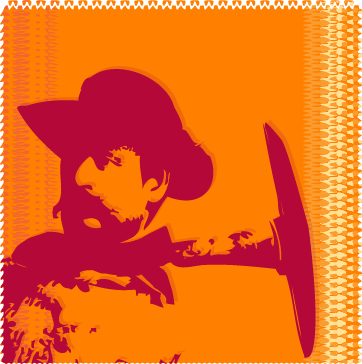Ashcroft Ghost Town is home to several relocated and restored historical buildings in the picturesque alpine meadows at storied the headwaters of Castle Creek, the ancestral hunting grounds of the Native Ute tribe, where silver was discovered in 1880. Located eleven miles up Castle Creek Road, trails, interpretive signage, and seasonal docents share the stories of the once-bustling transportation junction and mining town that rivalled Aspen.
Ashcroft Ghost Town
Location
11 miles up Castle Creek Rd. from the roundabout on Highway 82 at the west entrance to Aspen
Dogs are not permitted in the ghost town
Hours
Open June 14 - September 28
Wednesday - Sunday, 10 a.m. - 5 p.m. with docent
Self-guided and honor-system admission during closed hours and the fall, winter, and spring
Admission
$5/adult
Children 18 & under free (must be accompanied by an adult)
Free for active military personnel
Honor system admission box located on welcome sign
Highlights
- Docents and interpretive signage – chat with a docent during open hours, or enjoy a self-guided experience with recently-updated interpretive signage (Spanish-language translations available in print)
- Restored and relocated historical structures – intricate log cabin construction examples, shrubs indicating former building foundations, and varying remnants of every day life are found throughout the area
- Gift Shop – fun and funky memorabilia for every history fan (open during summer docent hours)
Ashcroft Ghost Town is within the White River National Forest. Aspen Historical Society operates, stewards, and funds the townsite under permit from the United States Forest Service.
There are limited services on Forest Service lands this summer; please recreate responsibly.
For more information about protecting public lands, visit roaringforkpubliclands.org. Be the reason public lands stay wild!

Discover Ashcroft in the Archives
View historical photographs, maps, and artifacts related to Ashcroft Ghost Town in the online archives.
Gallery

Grounds Rentals
Experience the magic of an historic ghost town located at the headwaters of the pristine Castle Creek Valley. This extraordinary site is available for ceremonies only and features stunning high alpine scenery in an unmatched historic setting.
Available June through September
Site History
1880 - 1885
Silver Mining
The Castle Creek Valley was once home to the Ute people, who used the area for summer hunting and foraging. However, with the discovery of gold and silver in the Colorado Territory, the Ute people were gradually displaced, and ultimately, in 1881, they were forcibly removed to reservations in southern Colorado and eastern Utah.

Silver was discovered in the upper Castle Creek Valley in the spring of 1880, when prospectors Charles B. Culver and W. F. Coxhead left the boomtown of Leadville to search for silver deposits in the area around Ashcroft. After vigorously promoting their findings back in Leadville, Coxhead returned to find 23 more prospectors had joined “Crazy Culver” in the camp they named Castle Forks City. They had already formed a Miner’s Protective Association, built a courthouse, and laid out the streets. The camp led to the establishment of Ashcroft, a transportation hub and mining town. However, the prosperity was short-lived.

1885 - 1912
Prospectors, Boosters & Town Fathers
As quickly as it boomed, Ashcroft went bust. Mines closed when ore veins turned out to be only shallow surface deposits. By 1883, Ashcroft residents were moving to Aspen, sometimes taking their cabins with them. Of the five mining camps established in the Roaring Fork Valley, only Aspen survived the mining economy boom-and-bust cycle.
Several attempts were made to revive the area. However, by 1912, the population had dwindled to less than 50 residents, and Ashcroft gradually became a ghost town.

Young men on mules in front of the Post Office at Ashcroft, circa 1900.

1916 - 1942
From Mining to Skiing
In 1936, the area’s first ski resort, Highland Bavarian Lodge, incorporated Ashcroft into its development. Unfortunately, the death of one of the partners during World War II led to the project’s downfall. During World War II, one of the other partners, Ted Ryan, gave permission for the US Army’s 10th Mountain Division to conduct training exercises near Ashcroft, where soldiers practiced climbing and bridge building.

1942 - 1973
Environmental Stewardship
In 1948, Stuart Mace, a 10th Mountain Division veteran, built Toklat Lodge across Castle Creek Road from the ghost town. Mace and his family ran a dog sledding operation from the lodge and acted as caretakers of the ghost town. Mace’s environmental stewardship preserved the valley’s pristine natural beauty for all visitors.

1974 - Present
National Historic Site
In 1974, Mace was joined in that effort by Aspen Historical Society when the USFS permitted AHS to manage the town site. Under the direction of Ramona Markalunas, Ashcroft became a Nationally Registered Historic Site.
Today, Ashcroft attracts thousands more tourists each year than the number of residents who have ever lived here. Ashcroft’s legacy is to educate about the history of those who lived, succeeded, and failed in this magnificent valley and to appreciate and protect its natural beauty.
Points of Interest

Point of Interest
Kinney Mercantile
The first businesses in Ashcroft catered to the needs of prospectors and miners who poured into the area, hoping to strike it rich. McCarthy & Flynn’s General Store was the first to open its doors, supplying everything from shovels to long underwear. Nellie Bird operated a lodging house out of a tent, and Ed Hughes’ Pioneer Saloon served the mostly male population. Mining-related professions such as surveyors, assayers, attorneys, and mining stockbrokers were also necessary to support the growing population.

Point of Interest









